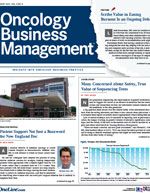Publication
Article
Oncology Business News®
No Consistency in Value Ascribed to Medical Scribes
Author(s):
The rise of electronic medical reporting and value-based standards and measures for improved medical care is supported by the best of intentions, but the implication is that physicians now spend more time behind the computer terminal and less time with patients.
OncLive Chairman,
Mike Hennessy
The rise of electronic medical reporting and value-based standards and measures for improved medical care is supported by the best of intentions, but the implication is that physicians now spend more time behind the computer terminal and less time with patients. They may have less time for each patient and they may be seeing far fewer patients each day.
If this represented a mere revenue loss, physicians might not be so unhappy about it. But the fact is that physicians report spending more and more time in the office each day. Some people, therefore, are not terribly surprised that so many smaller, less well funded practices are closing their doors or merging with larger institutions, or that it has become difficult to attract new physicians to the field of oncology.
For this August issue of Oncology Business Management, we investigated the possibility of medical scribes being one leg of a solution to this problem. We spoke with Linda Bosserman, MD, a medical oncologist at City of Hope in Rancho Cucamonga in Southern California, who prides herself on being an efficiency expert. Even for her, though, there is no way around the administrative chores that all oncologists face. When she packed up her bags recently for a one-week vacation, next to the toothbrush and the shampoo in her luggage she put what she estimated to be 50 hours of dictation work.
She would love to be able to use medical scribes in her practice to take over some of the mundane chores, but she doesn’t see how that’s possible given the degree of complexity of her work, which has been made more difficult by electronic reporting standards.
“The efficiencies are just becoming a major burden to the oncologist,” she says. “The burnout rate is skyrocketing and people are retiring early. They just don’t want to spend time in meaningless work.”
As this month’s story on scribes makes clear, the jury is still out on whether these helpers have a significant role to play in helping oncologists and hematologists get more done and derive more enjoyment from the profession. Michael Murphy, MD, CEO of ScribeAmerica, contends that scribe use is dramatically rising across most medical sectors, including oncology, though he would not provide numbers to support that assertion. He says scribes save time and money, enabling physicians to see more patients. Murphy’s organization employs roughly 7300 scribes, each of whom receives a month’s worth of training before starting regular employment. They receive periodic training updates after that, Murphy says.
Is that enough for an oncology practice? Bosserman says no, and contends that she’s not shooting from the hip. She’s given the matter thorough consideration, because she, like other physicians, needs a solution to the problem of increasing workload and tighter budgets. However, one physician who says he has made scribes work for him is Punit Chadha, MD, a medical oncologist and hematologist with Texas Oncology in Austin. Chadha began using them in his office 8 months ago and hasn’t looked back. The training doesn’t stop once they are dispatched from ScribeAmerica, he says. They work side-by-side with physicians in his office to learn the ropes, and their work is closely reviewed for accuracy. “Many of the scribes are also premed students, or have a strong science background,” Chadha told Oncology Business Management.
Does he now have more time for patients? The answer, he says, is an unequivocal yes.
Are scribes potentially useful for your practice? You read the article and do your own due diligence. You may come down on Bosserman’s side of the fence, or Chadha’s; or you may even decide that it’s time to merge your practice with a larger institution. But don’t give up until you’ve researched your options!










